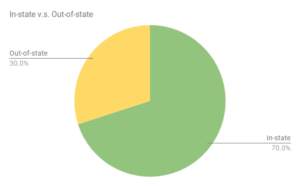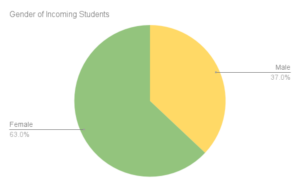By Ripon Media in College Days on September 3, 2017
This year’s incoming class is the largest since 2013
By Connor Renshaw
A new academic year means a new class of first-year Ripon College students. This August, the college is welcoming 238 new students into its student body, making the class of 2021 the largest group of incoming first-years since 2013.
With 238 students the class of 2021 is a break from a trend of smaller incoming classes of about 200 students which started in 2011. According to data from the Office of the Registrar, from 1999 to 2010 the yearly fall incoming class size remained relatively stable with the average size of all the fall incoming classes during that period being 257 students. From 2011 to 2016 the average incoming class became smaller with an average size of 218.5 students. The current incoming class is one of the largest in the past six years. It is rivaled only by the fall 2013 incoming class, which had the same amount of students.
The trend of smaller incoming class sizes is part of a recent drop in Ripon College’s overall student population. Between 2011 and 2017, the overall size of the student body went from about 1,000 students, a size where it had previously remained for a number of years, to 718 students during the spring 2017 semester. While student census information for the current semester will not become available until after Sept. 1, this semester’s incoming class outnumbers the 181 students who graduated last semester.
In addition to the 238 new first-years, Ripon College also is welcoming nine transfer students. This brings the total number of new students to 247. Out of this group, 63 percent of the students are female while 37 percent are male. The majority of new students come from within Wisconsin with 30 percent being out-of-state students. Nine of the new first-years are from outside the United States.
Sharon Jackson, director of student activities and orientation, said that she has been preparing this semester’s orientation committee to handle a larger class. She explained that during training she was “intentional about encouraging lots of facetime with new students because I don’t want them to feel like they’re getting lost in the shuffle because they’re in a bigger class.”
Jackson also anticipates that a larger incoming class might affect on-campus activities. “For student organizations it could mean the difference between ordering eight pizzas when you originally budgeted for five last year, between meeting in Joyce Lounge or MLK Lounge, or between holding multiple positions or having folks you can delegate tasks to,” she said. Jackson also said that the size of this year’s incoming class may affect how she determines what activities students will enjoy because “a larger class means more voices to consider.”





